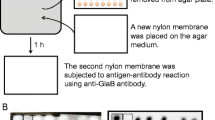Abstract
Aspergillus oryzae has two glucoamylase-encoding genes, glaA and glaB, whose expressions are distinguished by the type of culture used. The glaB gene is markedly expressed in solid-state culture but is little expressed in submerged culture. In solid-state culture, glaB expression at the transcriptional level is enhanced by low-Aw (water activity), high-temperature, and physical barriers to hyphal extension, as well as by starch. To determine the cis-acting factors in the glaB promoter, deletion analysis of the promoter was done with GUS (β-glucuronidase) as the reporter. Deletion of the 27 bp from −350 to −324 (Region A) in 1.1 kb of the glaB promoter completely abolished starch, low-Aw, and high-temperature induction. Substitution of the 12-bp GC-rich motif from −335 to −324 (GC-box) resulted in significant loss of starch and low-Aw inductivities. These findings suggest that the GC-box is a cis-element essential for the high-level expression of glaB in solid-state culture.
Similar content being viewed by others
Author information
Authors and Affiliations
Additional information
Received: 15 November 1999 / 18 February 2000
Rights and permissions
About this article
Cite this article
Ishida, H., Hata, Y., Kawato, A. et al. Identification of functional elements that regulate the glucoamylase-encoding gene (glaB ) expressed in solid-state culture of Aspergillus oryzae. Curr Genet 37, 373–379 (2000). https://doi.org/10.1007/s002940000118
Issue Date:
DOI: https://doi.org/10.1007/s002940000118




